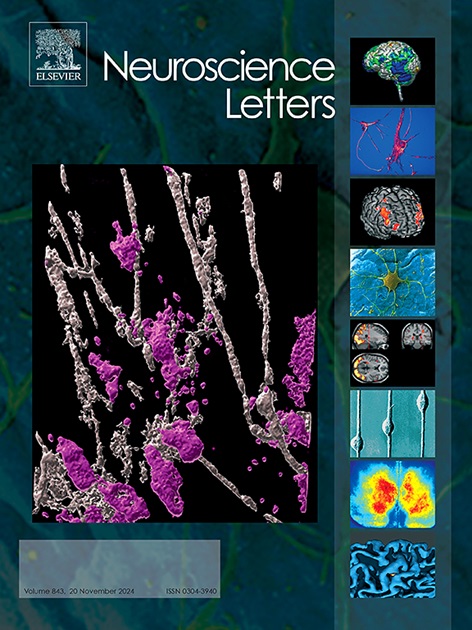Age-dependent changes in NMDA-induced excitotoxicity and neuromodulatory effects of kynurenic acid and its analogue in mouse brain slices
IF 2.5
4区 医学
Q3 NEUROSCIENCES
引用次数: 0
Abstract
Kynurenic acid (KYNA) is one of the main neuroprotective substances of the kynurenine pathway. KYNA plays an important role in various neurodegenerative and psychiatric diseases. Although KYNA has been shown to have neuroprotective effects, it cannot be used as a peripherally administered drug due to its poor ability to cross the blood–brain barrier. To address this limitation, chemically modified KYNA analogues are being developed: SZR72 is one such analogue and has been shown to be protective in various animal models. Glutamate-induced excitotoxicity is a key factor in many neurodegenerative diseases. Therefore, we used the N-methyl-D-aspartate (NMDA)-induced excitotoxicity model to investigate the neuromodulatory agents.
Using acute hippocampal slices from mouse brains, we investigated the potential neuroprotective effect of KYNA and its analogue, SZR72 on NMDA-induced excitotoxicity across different age groups of mice. The degree of tissue damage was assessed using biochemical and histological methods.
In young animals (1- and 4-week-old), NMDA treatment caused no significant changes, and the cells were found to be resistant. However, in older animals (8-week-old and 1-year-old), NMDA caused significant damage in cells and tissue structure, which was reduced by KYNA and SZR72 treatment.
To our knowledge, this is the first study to compare the neuroprotective effects of KYNA and SZR72 in animals of different ages using an in vitro NMDA excitotoxicity model.
小鼠脑切片中nmda诱导的兴奋毒性和犬尿酸及其类似物神经调节作用的年龄依赖性变化
犬尿氨酸(KYNA)是犬尿氨酸途径的主要神经保护物质之一。KYNA在各种神经退行性疾病和精神疾病中起重要作用。虽然KYNA已被证明具有神经保护作用,但由于其穿过血脑屏障的能力较差,它不能用作外周给药。为了解决这一限制,正在开发化学修饰的KYNA类似物:SZR72就是这样的类似物,并已在各种动物模型中显示出保护作用。谷氨酸诱导的兴奋性毒性是许多神经退行性疾病的关键因素。因此,我们采用n -甲基- d -天冬氨酸(NMDA)诱导的兴奋性毒性模型来研究神经调节剂。利用小鼠大脑的急性海马切片,我们研究了KYNA及其类似物SZR72对不同年龄组小鼠nmda诱导的兴奋性毒性的潜在神经保护作用。采用生化和组织学方法评估组织损伤程度。在幼龄动物(1周龄和4周龄)中,NMDA处理没有引起显著变化,并且发现细胞具有耐药性。然而,在老年动物(8周龄和1岁)中,NMDA对细胞和组织结构造成了明显的损伤,KYNA和SZR72处理可以减轻这种损伤。据我们所知,这是第一个通过体外NMDA兴奋毒性模型比较KYNA和SZR72对不同年龄动物的神经保护作用的研究。
本文章由计算机程序翻译,如有差异,请以英文原文为准。
求助全文
约1分钟内获得全文
求助全文
来源期刊

Neuroscience Letters
医学-神经科学
CiteScore
5.20
自引率
0.00%
发文量
408
审稿时长
50 days
期刊介绍:
Neuroscience Letters is devoted to the rapid publication of short, high-quality papers of interest to the broad community of neuroscientists. Only papers which will make a significant addition to the literature in the field will be published. Papers in all areas of neuroscience - molecular, cellular, developmental, systems, behavioral and cognitive, as well as computational - will be considered for publication. Submission of laboratory investigations that shed light on disease mechanisms is encouraged. Special Issues, edited by Guest Editors to cover new and rapidly-moving areas, will include invited mini-reviews. Occasional mini-reviews in especially timely areas will be considered for publication, without invitation, outside of Special Issues; these un-solicited mini-reviews can be submitted without invitation but must be of very high quality. Clinical studies will also be published if they provide new information about organization or actions of the nervous system, or provide new insights into the neurobiology of disease. NSL does not publish case reports.
 求助内容:
求助内容: 应助结果提醒方式:
应助结果提醒方式:


